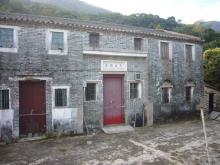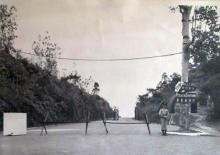BAAG 'Post Y', Chek Keng [????- ]
Primary tabs
Post Y was an important site in WW2, and still stands today.
Lawrence Tsui:
A BAAG post was set up at Chekeng Village - Post Y; which was also a HQ of the [Communist 'East River Brigade'] Guerrillas. The BAAG Advance HQ at Wai Chow (Huizhou) sent agents to HK through Post X (Shayuchung of Dapeng Bay), by guerrilla-operated junk to Post-Y (Chekeng) and throught the Ancient Route to urban Kowloon, one of the Safe House (Post-Z) being the Kwong Hang Store at Portland Street, Shamshuipo, which was operated by the Red Guerrillas.
Elizabeth Ride:
If you ever hike down to the village of Chik Kang [Chek Keng] on Long Harbour you will see the BAAG forward post, [ie Post Y] still intact. You can see two photos of it on p. 211 of Volume IV of the BAAG Series, which you will find in Special Collections, HKU Library. You will find information about Post 'Y' in Edwin Ride's book 'BAAG, Hongkong Resistance', p. 215-6, also in Special Collections.
Contact the caretaker if you can - he is a most interesting character.
Thanks to Kent Shum for providing the exact location. I've waked past here several times on the way out from Tai Long Wan without ever realising it's significance. I'll have to take a closer look next time



Comments
BAAG 'Post Y' Chek Keng
Post X-Y-Z was set up in the autunm of 1942 to serve as a clandestine line of communications between AHQ of the British Army Aid Group at Wai Chow and operatives in Hong Kong.
Post X was a store named Man Loong at Shayuchung at Dapeng Bay near the village of Kwai Chung. The beach was where Red Guerrillas interface with the Pro-Nationalist Government Guerrillas. BAAG operatives had to negotiate delicately with the two sides who were arch-enemies. Further north, BAAG Medical Posts were set up at key junctions along the way to Wai Chow to render aid to escaping PWs, BAAG Agents, as well as other evacuees.
Junks carrying BAAG operatives would often land at Tap Mun Island; then take a sampan to move up the Long Harbour to Post Y at Chekeng. Francis Lee Yiu-biu (later Captain, awarded MM & MBE) & Osler Thomas (Captain & MBE) were at Post Y during the early part of the Resistance War. The house used as Post Y was the one with Chinese sayings engraved over the door. The entire Saikung East Country Park of today, particularly Cheung Sheung, Tai Long, Tai Wan, Wong Mo Ying, Kei Leng, Shan Liu, Shum Chung, were guerrilla territories. The chapel at Chekeng is also one of the oldest Catholic churches in Hong Kong.
The BAAG had also a small junk or sampan operating between Shaukeiwan and Leiyumun. Two senior members of HSBC were led by BAAG agents to escape to Free China via this route.
Post Z at Portland Street was a store set up by Raymond Wong Chok-mui, with financed by the BAAG (according to guerrilla souces). Wong was a key member of the International (United Front) Work unit of the Hong Kong Kowloon Independent Brigade (which became part of the East River Colunm Guerrillas). He was also Agent No.99 of the British Army Aid Group. The safe house was operated by his family members. BAAG Agent No.25 Chan Yeung held secret meetings with Agent 99 at the loft of the shop until it was raided by the Japanese Kempatei mid-1943. Group B of the BAAG to which Chan belonged was purged. Wong was awarded MBE in 1947 and went to London to receive it. He became a Director of the News China News Agency, but was killed in an assassination attempt on Premier Zhou Enlai in April 1955, when a bomb exploded onboard an Indian airline plane 'Cashmere' on its way to a convention in Indonesia. Zhou had a last minute change of plan and did not board that plane.
BAAG withdrawal from Post Y
Lawrence Tsui writes:
The severe opposition of the Nationalist forced the BAAG to withdraw from its Post Y at Chek Keng Village, Sai Kung in mid-1943. However, a curtailed co-operation with the Reds continued throughout the War.
The murder of three priests
Dear Lawrence,
I would like to ask if you know anything about the death of three Catholic priests? Father Emilio Teruzzi (丁味略), Father Francis Wong (黃子謙) and Father Rene Kwok (郭景芸) were murdered in Sai Kung in late 1942, as record shown on the Archive of Catholic Church here:
http://archives.catholic.org.hk/In%20Memoriam/Clergy-Brother/F-Wong.htm
Father Francis Wong was murdered in Chek Keng 赤徑 in late November 1942, and the time coincided with the time that BAAG and red guerrillas set up Post-Y. And it is known that most East River Column meeting points were catholic churches, including Chek Keng, Shayuchung, Wong Mo Ying (黃毛應天主教堂). I wonder how was the relationship between the guerilla groups to the catholic villagers there during that time. I tried to find related informations in BAAG report, but haven't got any clues so far.
Thanks very much!
Cheong
Murder of Catholic Priests at Chek Keng
I did not come across any information in this regard. Francis Lee Yiu-piu who was BAAG man at Post Y Chek Keng was a Catholic. My father at the Field Intelligence Group at AHQ Wai Chow was also Catholic. I did not recall reading any report from them in this regard. Indeed, there was a Group G at AHQ which concerned using Catholic priests to approach the Japanese to obtain the humanitarian release of women & children at Internment Camps.
There were manyCatholic chapels in Saikung. There were Catholic Churches at Yim Tin Tz, Tailong Wan, also. The Red Guerrillas HQ moved into Saikung soon after the Japanese invasion in early 1942. They need not wait so long to kill the priests. I suspect the churches were abandoned already. I did not read anything in the Red Guerrillas legends of such murders.
Thanks!
Hi Lawrence,
Thanks for your prompt reply! I will try to search through Group G's reports to see if there's any related reports.
The priests had been visiting the chapels in Saikung until the tragedy happened, according to the webpages on the Archive of the Catholic Church. So I suppose the churches were not yet abandoned in late 1942. It's possible that the priest might have spoken against the guerrillas, or the guerrilla group might have changed their attitude towards the catholics. If they were involved in the crime, they might have kept it in secret and it was possible that Francis Lee and other BAAG agent were not aware of that at all. But it's certainly also possible that the murder was done by other bandits, the Japanese or their puppet military.
Cheong
catholic priests
Hi licheong
Some of your answers might be found in Dr Patrick Hase's History of the Catholic Church in Taipo. You can download a PDF from the church website: http://taipo.catholic.org.hk/wp-content/uploads/2013/05/150+50_Publicati...
Regards
Phil
Thanks Phil! I didn't notice
Thanks Phil! I didn't notice that they have a longer account on their history. Although the evidence isn't conclusive, that's a much more detailed account on what had happened.